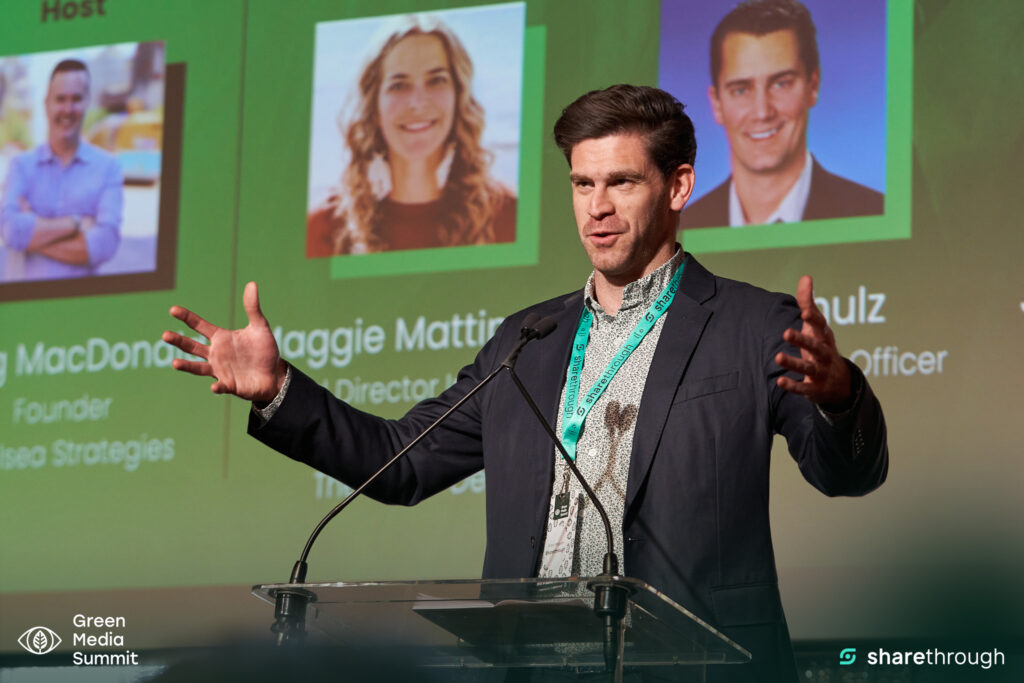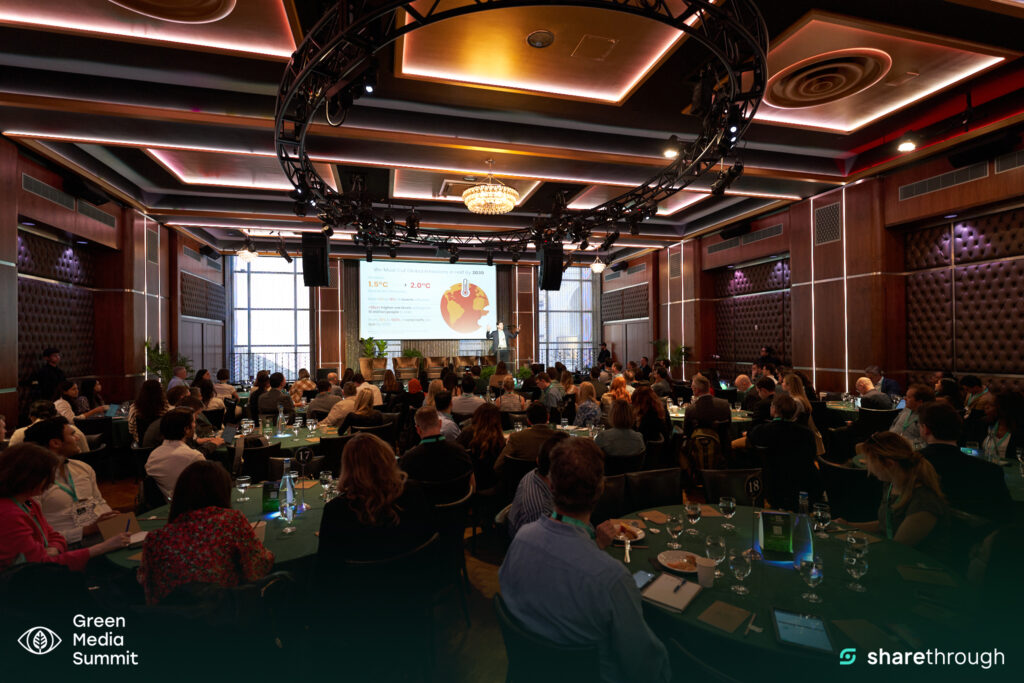|
Getting your Trinity Audio player ready...
|
On April 13, the first Green Media Summit took place in NYC bringing over 250 attendees from across the media ecosystem to discuss how the industry can move towards a more sustainable future.
With advertising still a significant source of publisher revenue, moves by brands and their intermediaries to become more environmentally sustainable is a trend that publishers ignore at their peril – brands are now demanding to know what initiatives their publisher partners are implementing as part of their own supply chain audits.
This landscape formed the background to the Green Media Summit, organized by Sharethrough, with over 250 attendees and 25 speakers from 160 brands, agencies, publishers and adtech companies coming together at the Edison Ballroom in New York. The subject? How the advertising industry can work with its partners to become one of the first industries to reach net-zero carbon emissions.
The event included a mix of keynotes, interviews and panels with sustainability experts both in and out of the advertising industry. The event started with Noel Anderson, chief sustainability officer of the American Red Cross, followed by sustainability leads from each part of the digital advertising supply chain for separate discussion panels, including separate conversations for brands, agencies, DSPs.




6 Key Takeaways
1. Don’t wait for perfection to start reducing emissions and improving sustainability
Noel Anderson, the chief sustainability office from American Red Cross kicked off the Green Media Summit with a macro-level view of how climate change is impacting mankind. Any action on sustainability is positive, and the advice for the organizations present was to get started rather than wait for perfection. Curt Larson, Chief Product Officer of Sharethrough, who also sits on the board of the IAB Tech Lab, said, “if your house is on fire, the fire department doesn’t sit outside and discuss until they have the perfect plan of which room to start with first. They start fighting the fire right away.”
While there are organizations like 51toCarbonZero, who spoke at the summit about how to develop a plan to measure and reduce carbon emissions, there is no right or wrong place to start. Sustainability is a continuous process. And at some point, organizations will reach net zero, so it really doesn’t matter where they start, as long as they start now.
2. Brands can be both sustainable and profitable
There is a business case for being sustainable. A recent study by McKinsey and NielsenIQ concluded that products making sustainability claims averaged 28% growth over the past five-year period, versus 20% for products that made no such claims. On the “Building a Sustainable and Profitable Brand” panel, Jennie Mucciarone, Digital Media Strategist from iRobot echoed that sentiment and added how iRobot’s efforts to make their products more energy efficient lead to product innovations that also improved the speed and efficiency of their robot vacuums.
On the advertising front, Mucciarone said that when they started running media on green media products (for example, Sharethrough’s GreenPMPs) that measure and compensate for the emissions generated by their ads, they saw visible performance improvements.
A focus on sustainability can lead to better innovation, improved revenue, better advertising outcomes and a better company culture that cares about doing good for the world and for its employees.
3. The ad industry needs standards for how to measure carbon emissions
Nearly every session at the Green Media Summit included a call for a common carbon emissions measurement standard. This currently does not exist, with organizations measuring different aspects of their business leading to a disjointed industry approach. The most stunning call for agreed standards came from the panel of agency sustainability leads from GroupM, Publicis, IPG and Havas who all said that they need to work together to agree on standards.
Sharing data with partners is critical to creating a more transparent portrait of emissions. If we can prove that by being more sustainable you’re actually yielding higher ROI for marketers, [then] market dynamics will motivate us to do the right thing.
Martin Bryan, Global Chief Sustainability Officer at UM, Mediabrands
However, who should develop and police these standards? The IAB Tech Lab, AdNetZero and Scope3 all weighed in on their own efforts at the summit to create standards for the industry. These major agencies are communicating together and bringing in all parts of the advertising ecosystem to develop a solution, which needs to appear soon.
4. Advertisers have the buying power to catalyze sustainability efforts
Sustainability initiatives will only be prioritized if those with buying power, i.e. ad agencies, demand it from their partners. From enforcing standards to requiring the use of renewable energy to power data servers, advertisers have the power to make it happen. Hillary Slattery, Director Programmatic at IAB Tech Lab spoke about their efforts to create carbon measurement solutions that are as easy to implement as ads.txt or sellers.json. Curt Larson pointed out how those two initiatives had the fastest industry-wide adoption because certain agencies or DSPs required the adoption.
The Ad.txt and Sellers.json adoption was quick because buyers were demanding it, and the same thing can happen with sustainability standards.
Hillary Slattery, Director Programmatic, IAB Tech Lab
5. Green media needs to be as easy and performant as possible to increase adoption
Demand-side-platforms (DSPs) can help facilitate sustainability by improving the ease for programmatic ad buyers to identify and purchase net-zero, net-neutral or at least reduced emissions supply paths. The easier DSPs can make it for advertisers to transact, without impacting performance, the faster green media products will expand. These solutions will further incentivize publishers that have made efforts to reduce their carbon emissions.
DSP’s can also play a really important role in reducing the industry’s carbon footprint resulting from fraud or bad destinations creating poor inventory experiences. By continuing to learn who the bad actors are and declining their open bids, we can work to make it unprofitable for those players to take part in the industry, ultimately helping to reduce carbon emissions and increasing potential revenues for quality publishers.
Joseph Dressler, the VP of Sales for Adform
6. Supply path optimization can reduce emissions from both the buy and sell side
Supply Path Optimization (SPO) was discussed numerous times throughout the event as an effective solution to reduce carbon emissions. Every step an ad takes in the programmatic ecosystem demands more energy and computing power, causing more carbon emissions to be emitted. Thus, minimizing the number of steps an ad takes can significantly reduce the carbon emissions of an organization as a whole. Advertisers can achieve this by identifying and optimizing the most efficient supply paths to reach their desired publisher, while publishers can limit the number of partners allowed to bid on every impression or fire pixels.
At the summit, Chao Liao, SVP of Revenue Ops & Data Strategy at Insider Advertising, shared that Insider reduced its carbon emissions by 20% in the first quarter of 2021 by evaluating their ads.txt files and removing resellers and partners generating limited revenue, without any impact on revenue.
Brian O’Kelley, CEO and co-founder of Scope3, added that SPO efforts and even removing wasteful sites like made-for-advertising sites has three positive impacts: one, advertisers achieve better outcomes, two, more advertising budgets are funneled to more premium publishers who can then hire better writers and journalists and three, carbon is reduced across the full supply chain.
We can do this! No industry knows data better than advertising so no industry is more qualified to read that data and make a difference in our carbon footprint.
Brian O’Kelley, CEO and Co-Founder, Scope3



